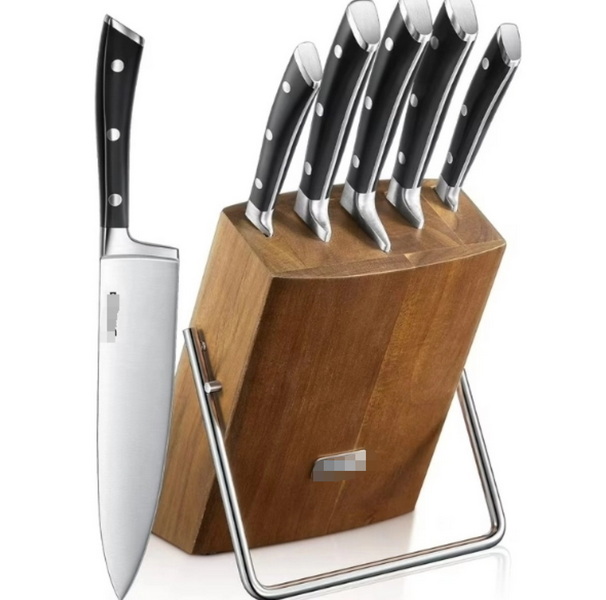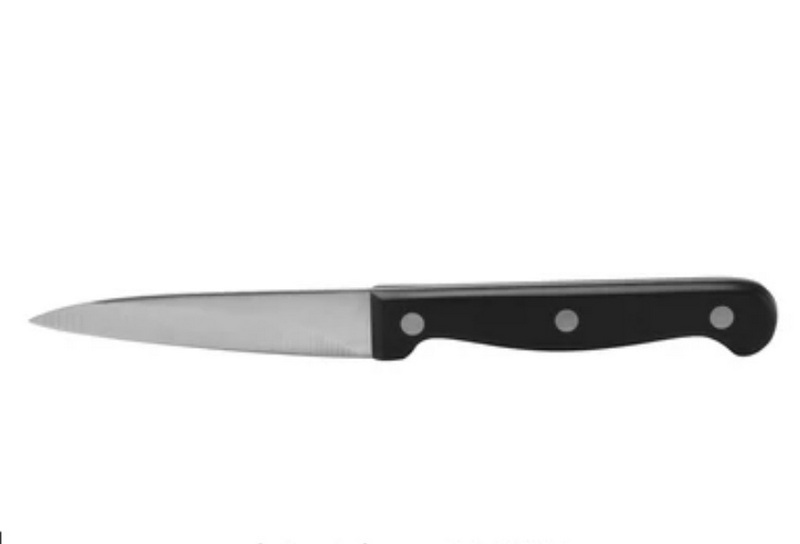- All
- Product Name
- Product Keyword
- Product Model
- Product Summary
- Product Description
- Multi Field Search
Views: 222 Author: Ann Publish Time: 2025-10-22 Origin: Site











Content Menu
● What defines a high-quality Paring Knife?
● Why chefs and home cooks rely on a Paring Knife
● Key features to evaluate when purchasing
● How to choose for different use cases
● Usage guidance for optimal results
● Branding and OEM considerations for Paring Knife products
● Photographic and video content plan (placeholders)
● Historical and design context
● Comparative considerations with other pocket-sized tools
● Technical deep-dive: materials science and ergonomic optimization
● Global market implications for Paring Knife OEMs
● Practical assembly considerations for manufacturing partners
● User-centric usage scenarios and demo ideas
● FAQ
>> What is a Paring Knife best used for?
>> How should I sharpen a Paring Knife?
>> What materials make the best handle for a Paring Knife?
>> Is a serrated paring knife better for certain tasks?
>> How should I store a Paring Knife to maintain its edge?
A paring knife is a small, versatile tool that can transform everyday kitchen tasks from tedious to precise. In professional kitchens and home setups alike, the paring knife fills a niche that larger knives cannot efficiently reach. For OEM brands seeking to showcase quality, a well-crafted paring knife communicates attention to detail, balance, and control. This article explains why every kitchen needs a high-quality paring knife, outlines features to look for, and provides practical guidance for choosing and using the right paring knife.

- Blade material and edge retention: High-quality paring knives typically use premium stainless steel or high-carbon steel alloys that resist corrosion and can maintain a sharp edge with regular maintenance.
- Blade geometry: A thin, sharp point and a slightly curved belly enable precise peeling, trimming, and delicate work on fruits, vegetables, and small produce.
- Handle design and balance: An ergonomic handle that fits the hand comfortably reduces fatigue during extended prep sessions. Proper balance between blade and handle enhances control.
- Tang and construction: Full tang construction and secure assembly improve durability and tip-to-handle stability during fine tasks.
- Fit and finish: Uniform grind, minimal blade play, and a smooth finish reflect overall quality and longevity.
- Precision peeling and trimming: The paring knife shines in tasks requiring delicate removal of skins, cores, and blemishes without sacrificing flesh or presentation.
- Detail work on garnishes and fruit carving: Intricate tasks, such as decorative garnishes or precise fruit shaping, are well-suited to the paring knife's controllability.
- Complement to larger knives: While chef knives handle bulk cuts, the paring knife handles the fine-tinish work, creating a complete, efficient toolkit.
- Blade material: Stainless steel vs. high-carbon steel. Stainless is more forgiving in moisture-rich environments, while high-carbon offers superior edge retention but may require more maintenance.
- Hardness rating (HRC): A higher HRC often correlates with sharper edges and longer life, but may impact ease of sharpening and chip resistance.
- Edge geometry and grind: Micro-serrated vs. plain edge, hollow-ground versus flat-ground; each affects sharpening frequency and slicing performance.
- Blade width and tip geometry: Narrow tips provide precision, while wider blades offer added stability for certain tasks.
- Handle material and ergonomics: G10, pakkawood, composite, or polymer handles each offer different grip feel and moisture resistance.
- Maintenance requirements: Some blades benefit from regular honing and periodic sharpening; others are more forgiving with routine care.
- Home cooks focusing on fruit and vegetable prep: A slim-blade paring knife with excellent edge retention and a comfortable handle will maximize daily efficiency.
- Professional kitchens with heavy use: A robust blade with a durable edge, reinforced tang, and a balanced handle will withstand frequent sharpening and cleaning.
- Gift or brand differentiation: Consider unique handle materials, engraving options, and packaging that reflect your OEM branding while preserving functionality.
- Hand wash and dry promptly: To protect the blade and handle, avoid dishwasher exposure and dry after washing.
- Honing vs sharpening: Regular honing maintains edge alignment; sharpening should be performed when the knife feels dull or after noticeable performance decline.
- Storage: Use blade guards or a knife block to protect the edge and prevent accidents.
- Cutting surface: Use a soft-board or plastic cutting surface to reduce edge dulling.
- Peeling fruits and vegetables: Use a light rocking motion and keep the blade close to the reference surface to minimize waste.
- Deveining shrimp or trimming small proteins: The paring knife's precision allows clean, controlled cuts with minimal damage to surrounding tissue.
- Garnishing and decorative tasks: Steady hands and micro-adjustments yield consistently shaped results.

- Customization options: Handle color, material choices, logo placement, and packaging customization can differentiate your OEM brand.
- Material sourcing: Selecting reliable suppliers for blade steel, handle materials, and coatings ensures consistent quality and supply stability.
- Quality assurance: Implement standardized tests for edge retention, corrosion resistance, and ergonomic comfort to meet international market standards.
- Regulatory compliance: Ensure compliance with food-contact safety regulations and labeling requirements across target regions.
- Hero image: A high-resolution shot of the paring knife on a clean cutting board to establish the product's premium look.
- Close-up blades: Macro images showing the blade grind, edge bevel, and finish.
- Handle detail: Close-ups highlighting material, texture, and grip ergonomics.
- In-use demonstration video: Short clips showing peeling, trimming, and precise detail work to illustrate real-world performance.
- Maintenance video: A quick guide to honing, sharpening, and care routines.
- Packaging showcase: Images of OEM packaging concepts and branding options.
- Evolution of paring knives: From utilitarian single-blade designs to modern high-performance blades that balance sharpness, durability, and comfort.
- Design trends in OEM markets: Consumers seek knives that combine aesthetics with practical performance, driving collaborations that emphasize material science, ergonomic handles, and durable coatings.
- Paring knife vs utility knife: Paring knives often offer more precision and control for delicate tasks, while utility knives cover broader ranges of cuts.
- Paring knife vs boning knife: Boning knives are specialized for bone work; paring knives excel in skinning, trimming, and detailing.
- Blade steel composition: Carbon content, chromium for corrosion resistance, vanadium for wear resistance, and optional cobalt or molybdenum for toughness. A balanced alloy delivers both edge retention and resilience under daily kitchen abuse.
- Heat treatment and microstructure: Proper annealing, quenching, and tempering yield a blade that holds a sharp edge while resisting chipping. The microstructure affects sharpness stability during repeated honing.
- Surface finishing: Polished versus satin finishes influence food release and aesthetic appeal. A satin finish can hide micro-scratches from heavy use, while a mirror finish may require more maintenance.
- Ergonomic studies: The shape of the bolster, finger guard, and tang alignment affect fatigue reduction and precision control during long prep sessions. A well-designed handle distributes pressure evenly across the palm and fingers.
- Regional preferences: Some markets favor lighter-weight handles and softer steels for ease of maintenance, while others prioritize premium steels and intricate handle marquetry for brand storytelling.
- Packaging and messaging: OEM branding can leverage sustainability claims, origin stories, and demonstration videos to differentiate products in crowded markets.
- Compliance and labeling: Adhere to food-contact safety standards, country-specific marking requirements, and bilingual packaging to accommodate diverse consumer bases.
- Blade-to-handle fit: Ensure consistent tang fit, tight alignment, and flawless grinding to minimize blade play and maximize user confidence.
- Quality control checkpoints: Implement in-line hardness testing, blade edge inspection, and handle surface finish verification to maintain uniform product quality across batches.
- Coatings and corrosion resistance: If applying non-stick or protective coatings, assess interaction with cutting tasks and maintenance routines to avoid performance penalties.
- Packaging engineering: Design packaging that protects the blade during transit while presenting branding elements clearly; consider consumer usability such as easy opening and included maintenance guides.
- Fruit carving contest: Demonstrate the precision of the paring knife in creating delicate fruit shapes for garnishes or competitions.
- Asian culinary applications: Highlight lightweight control for intricate cuts used in garnishing and plating in fusion and traditional cuisines.
- Home-kitchen to pro-kitchen transition: Show how a quality paring knife remains essential from a home setup to a professional environment, reinforcing OEM value propositions.
A high-quality Paring Knife is an essential tool for both professionals and home cooks. Its precision, control, and versatility make it a cornerstone of any kitchen toolkit. For OEM brands, delivering paring knives with superior materials, ergonomic design, and strong branding elevates customer satisfaction and market differentiation. A well-chosen Paring Knife can transform everyday prep into a refined, efficient experience.

It excels at peeling, trimming, coring, and intricate detail work on fruits, vegetables, and small proteins.
Regular honing keeps the edge aligned; sharpen when performance drops, choosing a sharpening stone or steel aligned with the blade's grind angle.
Handles range from pakkawood and steel to polymer composites like G10 or FRN; select based on grip comfort, moisture resistance, and brand aesthetics.
Serrated edges work well for tasks involving tough skins; however, most paring tasks benefit from a plain edge for precision.
Use a blade guard, magnetic strip, or dedicated knife block to minimize edge dulling and ensure safety.
The Ultimate Professional Knives for Halal Butchery in Middle Eastern Kitchens
Chef Knife Size Guide: Choosing Between 6″, 8″, 10″, And 12″
Custom Knife Handles: How To Design A Chef Knife That Fits Your Hand Perfectly
Chef Knife Surface Treatments Guide: From Polished Migaki To Damascus Patterns
Inside Our Professional Knife Sample Room: Quality You Can See
Universal Knife Block Buying Guide: Modern Acrylic & ABS Knife Holders for Professional Kitchens
Universal Knife Block: The Complete Guide To Modern, Hygienic Knife Storage
The Complete Guide To Red Handle Knife Sets: Style Meets Functionality in The Kitchen
Professional Knives for Halal Butchery And Middle Eastern Cuisine